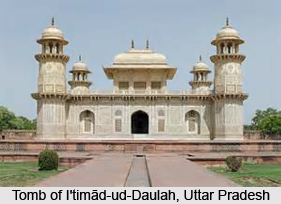 Tomb of I`timad-ud-Daulah is a famous Mughal mausoleum in Agra city in the northern Indian state of Uttar Pradesh and is often referred to as `jewel box` or `Baby Taj`, as it closely resembles the world-famous monument, Taj Mahal. Several gardens and buildings are associated with the principal structure of the Tomb of I`timad-ud-Daulah which was established between the period from 1622 and 1628. It can be termed as a classic representation of architectural transition from the initial phase of Mughal architecture which was characterised by beautiful marble decorations and red sandstone (as in Humayun`s Tomb, Delhi and Akbar`s tomb, Sikandra) till its secondary phase which was marked by rich inlay work of `pietra dura` and white marble.
Tomb of I`timad-ud-Daulah is a famous Mughal mausoleum in Agra city in the northern Indian state of Uttar Pradesh and is often referred to as `jewel box` or `Baby Taj`, as it closely resembles the world-famous monument, Taj Mahal. Several gardens and buildings are associated with the principal structure of the Tomb of I`timad-ud-Daulah which was established between the period from 1622 and 1628. It can be termed as a classic representation of architectural transition from the initial phase of Mughal architecture which was characterised by beautiful marble decorations and red sandstone (as in Humayun`s Tomb, Delhi and Akbar`s tomb, Sikandra) till its secondary phase which was marked by rich inlay work of `pietra dura` and white marble.
This tomb is based on the right bank of Yamuna River and is constructed in a huge crucifix which is interspersed by walkways and water courses. The structure is spread over an area measuring about 23 square metres, built on a platform measuring about 50 square metres and one metre in height. Hexagonal towers are present along its corners which measure about 13 metres in height. Its walls are composed of white marble imported from Rajasthan and are engraved with semi precious stones like topaz, lapis lazuli, cornelian and onyx, made over images of wine bottles and cypress trees, apart from designs of vases and cut fruits. Elaborately chipped marble has been utilized to manufacture the charming white `jali` screens which permit light to intrude its interiors. The mausoleum contains the graves of several relatives of Nur Jahan. The cenotaphs of the parents of Nur Jahan have been kept side by side, a manner which has been duplicated in the Taj Mahal.
This article is a stub. You can enrich by adding more information to it. Send your Write Up to content@indianetzone.com




